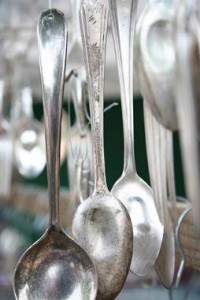
Humans are ridiculous and wonderful. We are incandescent spirits walking around inside clumsy, fragile meat–puppets, and we are such clever creatures that we routinely exceed the survivability limits of our bodies. Every day, many of us hurl ourselves into the world at speeds exceeding 60 mph, wear lightweight clothing despite temperatures that could cause hypothermia and death, and stand beside our food while we bombard it with electromagnetic radiation that can cook flesh from the inside out. We think nothing of it.
When our bodies fail to work the way we want them to, we apply the same ferocious ingenuity to surpassing physical limitations imposed upon us. As a species, we keep pushing forward and we don’t give up, no matter how many absurd (or horrifying) dead–ends we run into.
In 1917, a desperate Kansas farmer named Stittsworth came to the young Dr. John Brinkley. Today, his complaint could be fixed by the company that brings us television ads of a man and a woman watching the sunset while reclining in separate bathtubs. Back then, all the doctor could offer was a joke about needing the glands from a randy goat. The farmer took him seriously and demanded a transplant, the doctor obliged, and an empire was born. When the farmer spread the word that he’d been cured by having bits of goat gonads implanted in his testicles, other desperate men lined up for the operation. Soon, Dr. Brinkley claimed the procedure could also cure the flu, acne, high blood pressure, and even insanity. He performed over 16,000 goat testicle transplants — a world record that we can all hope will never be beaten.
You’ve probably heard similar stories about the horrific practices that humans throughout time have undergone in hopes of a cure. In the Middle Ages, barber–surgeons performed bloodletting to flush out the bad humors that caused illness. The red stripe on modern barber poles stands for blood, the white stripe for bandages, and the caps on either end for the leech bowl and the blood collection bowl. During the Victorian heyday of leeching, leeches were even applied internally — yes, exactly where you were just thinking of.
In the 1700s, people consumed a syrup of garden snails to soothe sore throats and coughs. That may have actually worked, but it’s pretty unlikely that sliding de–shelled snails into your ear helps with earache.
In the early 1900s, the “Rattlesnake King” grew popular by killing rattlesnakes to advertise his snake–oil–derived medicine. Since he made it mostly of mineral oil, with a little beef fat, red pepper, and turpentine thrown in, it didn’t cure anything — but it did at least gain immortality in the phrase, “snake oil.”
Before the introduction of penicillin in the 1940s, doctors used mercury to treat diseases, primarily syphilis. This despite the notorious madness of hatters, which was by that time well known to be caused by mercury exposure.
Humanity’s history is littered with travesties and adorned by equally stunning triumphs. Our medical history is cut from the same cloth. In addition to the great leaps forward in medical science that we’ve all heard about, it is elevated by individual victories.
During the Dark Ages, most prosthetic limbs were barely a cut above hook hands and peg legs. When knights lost limbs, their armorers constructed sheaths mostly to conceal the deficit from their enemies. A leg would sit in a stirrup. A hand might hold a banner, but nothing more.
Then came the Renaissance, a time of great advancement in medical science, as in so many other fields. In the early 1500s, Götz von Berlichingen lost his right arm during a siege in Bavaria. The iron hand constructed for him was a mechanical masterpiece with spring action, articulated fingers, and a series of releases to enable position changes. He could hold a quill, play cards, direct his horse, and grip a lance. It allowed him to continue his military career. Thanks to this futuristic–for–its–time technology, he lived to a ripe old age and left behind a legacy of three daughters, seven sons, and the assertion, “er kann mich im Arsche lecken,” which has come into modern English as, “He can kiss my ass.” That doesn’t sound like a man slowed down by his injury.
Thanks to human inventiveness and our ability to adapt and overcome, every age is an age of miracles and wonders. In modern times, we no longer need an armorer, or even a doctor, to make a prosthetic hand. The Robohand can be made by anyone with access to a 3–D printer. An American puppeteer and a South African carpenter with a mangled hand collaborated to design the printable prosthesis’ blueprint. First they created a hand for the carpenter. Then they made one for a five–year–old with missing fingers. They made the blueprint available for free online. The South African carpenter kept fitting children with new hands — over a hundred, at last count. Meanwhile, a Massachusetts father found the blueprint and used a school’s 3–D printer to make a new hand for his son. A Kansas teenager went to a public library and printed a hand for a family friend, a nine–year–old boy born missing the four fingers of his right hand. The latest design of the Robohand snaps together like Legos, and it can be made for a materials cost of about $5.
3–D printers are restoring more than just hands, too. Using living cells as the printing medium, surgeons can produce transplantable kidneys. Other organs are coming soon. German doctors printed a jaw–bone model and used it to build a titanium–and–bone mandible that they implanted in the patient’s shoulder muscle for seven weeks, until it was ready to be moved to his jaw.
Our understanding of how brain and body work is still growing and changing. Only a few months ago, for example, surgeons from University Hospitals Leuven in Belgium announced that they had discovered a new knee ligament. This explains why some knees still buckled even after having surgery that should have repaired all the torn ligaments.
We live in a world of medical advances that science fiction writers of previous generations barely dreamed of. Open–source programming has leapfrogged from word processing and game applications to robotic surgery systems. A cybernetic hand gives amputees a sense of touch by transmitting electrical impulses to electrodes surgically implanted on nerves in the upper arm. Brain implants control epileptic seizures. Stressing techniques convert mature cells into pluripotent stem cells, which can then transform into almost any kind of cell in the body. In the last two years, we’ve gone from the first quadriplegic to control a fully mobile robot arm with her mind (and use it to feed herself chocolate) to a paralyzed teenager who will use a lower–body exoskeleton to stand, walk, and kick the opening ball at the World Cup 2014 in Brazil.
When we are struck down by injury or disease, today we can usually be healed or use adaptive devices to overcome maladies that, only a few centuries ago, would have been death sentences. When one treatment doesn’t work, there is always another medical trial waiting in the wings.
Yet even as we hover on the edge of technological transcendence, our humanity is what gets us through the day. After the inventors and the engineers and the roboticists and the surgeons do their work, they leave. Then comes the challenge of rebuilding a life. In many cases, it won’t be quite the same life as it was before.
The difference may be small. We may lose a few degrees in our range of motion. We may have to avoid certain movements because they grate against painful scar tissue. We might not be able to reach the highest cabinet or lift the heavy bag of cat litter. We might have to give up running or skiing or cartwheels or driving a car. We may need to wear wrist braces or knee braces or carry a cane sometimes, just in case.
The difference may be large enough to swallow the world as we know it. We may need special accommodations just to be able to use the toilet. We may suffer from pain that recedes sometimes, but never leaves entirely. Simple daily routines that used to take ten minutes might now take a full hour and leave us exhausted for the rest of the day. We might begin to see life as an obstacle course that forces us to constantly run time–and–pain vs. benefit calculations. We may endure humiliations thoughtlessly inflicted on us by other people who don’t understand or never considered or simply don’t care.
Perhaps the difference is mental instead of physical, a new awareness of dangers and pain–in–waiting that affects what activities we are willing to do and how we move through our lives. Maybe we’re aware of the changes in how we feel. Maybe they’re a confused tangle that rises up to trip us when we least expect it.
A different set of experts comes in when we seek help in rebuilding. Depending on the circumstances, psychiatrists and physical therapists may both be useful. Treatment advances have been made here, too. Anti–gravity treadmills reduce the stress on joints. Remote–controlled aluminum and titanium exoskeletons teach patients how to walk again. Virtual reality desensitizes war veterans to PTSD triggers. If that fails, treating post–traumatic stress disorder with MDMA (street name: Ecstasy) may also lead to long–term improvement.
For most people who are recovering from an injury, sessions with a physical therapist are finite in number. Physical therapists work toward concrete goals: writing your name, walking a mile, being able to tie your own shoes, or rolling over in bed without pain. To get the most out of physical therapy, figure out what your specific, small–scale goals are — and tell them.
Eventually, a point is reached where further improvements become a matter of incremental change over long periods of time. It seems like the end of the road. But years after we’ve adjusted to our new limits, we may discover that they’ve shifted, just a little bit.
While we struggle to restore our bodies’ functionality, we also begin to pick up the pieces of our lives that were broken by our sudden inability. Sometimes physical ordeals are predictable, like planned surgeries or childbirth. If you’re lucky, you were able to plan for it ahead of time. It can be very useful to figure out what will be needed to restart different areas of your life. Then make a plan for how and in what order you’re going to do so. Even if you didn’t have the opportunity to plan beforehand, you might try taking some time at the beginning of the recovery process to think about how you want to construct your new life.
Spoon Theory is a great way to explain living with physical conditions that affect your day–to–day existence. Imagine that you are given a handful of spoons at the beginning of the day. Everything you do (or, in some cases, don’t do) costs a spoon, from washing your hair to standing on a train to not getting enough sleep or skipping lunch. Your spoons run out quickly, and you’re forced to make difficult choices about what activities are most important to you on any given day. Christine Miserandino designed Spoon Theory to help explain living with an invisible disability, but it’s also a practical tool for adjusting to new limitations. If you’re recovering from a physical injury, the number of spoons you get will slowly increase over time. If you’re trying to rebuild your life while managing a chronic condition, your number of spoons may remain steady, or it may wax and wane depending on what phase you’re in.
So how do you decide where to spend your spoons?
Everybody’s first step to reconstructing their life is different, but one possibility is to start your daily routine by looking at your calendar, your list of deadlines, and your “would usually do” items. Keep track of important dates so that they don’t sneak up on you. Prepare for these in advance as much as you can, even if that only means laying out your clothes and setting the table for breakfast the night before you have a morning appointment. As they come up, create a list of things that you would usually do at that time, can’t right now, but want to eventually. If there are complicated tasks that you do regularly, try writing out step–by–step instructions. It may be quite some time before you can get back to them, or you may have to do them while under the influence of painkillers or other drugs that affect your memory and ability to concentrate.
Humanity has thrived because we are adaptable. We have expanded into so many ecological niches that we should be classified as an invasive species. Through the centuries, whether our medical treatments succeed or fail, we persevere. As long as we are this side of the grave, we are able to go beyond simple survival to make a life for ourselves. In many cases, the life we rebuild will not be the same as it was before, but it will be a life, and it will be ours.











